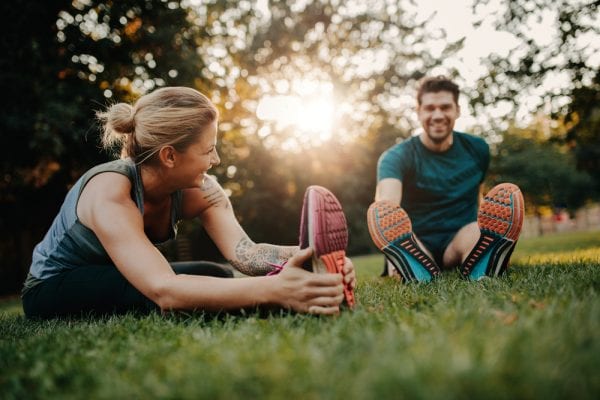
Exercise is often thought to be beneficial for the physical body but getting active actually has some profound benefits for the mind as well.1,2 The human mind and body are so interconnected that what’s good for one is often good for the other, and this is certainly true with exercise.
The benefits of exercise are plentiful and extend to people of varying skill levels and abilities.
This article will explore the connection between exercise and mood and emphasize how joint pain sufferers should continue to exercise to gain important mood-elevating benefits. Not only can exercise help reduce joint pain, but it can also dramatically reduce the mental frustration of living with arthritis every day.
The Effects of Exercise on the Mind
Getting the body moving releases endorphins, which are natural chemicals that make a person feel good.3 Exercise also has a way of distracting the mind in a healthy way and away from worries and negative thoughts that can lead to anxiety and depression.4,5 With regular exercise, individuals can cope with problems without resorting to negative behaviors, gain confidence, and even become more social.
Research evidence also suggests that exercise can help improve memory by increasing activity in the hippocampus part of the brain, improve cognitive performance, and reduce pain with both high-impact and low-impact activities.2,6,7 Additionally, exercise may help the mind be more creative, productive, and even help control addictive tendencies.8
Endorphins Exercise and Elevated Mood
It’s often very easy to notice the effects of exercise on the mind because mood enhancements can occur within just the first few minutes of working out. However, the effects of exercise go beyond just this initial feeling and are long-lasting too.9,10
Research has shown that exercising on a regular basis can help prevent long-term depression, reduce negative thoughts in challenging situations, and help people cope with stress in better ways.
Considerations About Exercise and Joint Pain
Many people who suffer from arthritis are hesitant to exercise out of fear that moving sore joints will only make their conditions worse. One important thing to remember about exercise and joint pain is that getting active doesn’t always have to include planned, repetitive activities, such as going to the gym or running laps.11 Physical activity in all forms, including backyard chores and playing with the family dog, provides valuable mood-boosting benefits as well.
In addition to elevated mood, the benefits of exercise for joint pain sufferers include less overall pain because exercise increases blood flow to the joints, builds muscle around the joints to support them, and improves range of motion to provide greater flexibility and resilience to excess pressure.12 With all of these beneficial effects of exercise and so many more, joint pain sufferers owe it to themselves to talk to their doctors about the types of exercise that are safe to practice for improved physical and mental health.
REFERENCES FOR THE AMAZING CONNECTION BETWEEN EXERCISE AND MOOD
1. The benefits of playing sports aren’t just physical! Office of Disease Prevention and Health Promotion. Retrieved November 10, 2018 from https://health.gov/news/blog-bayw/2012/05/the-benefits-of-playing-sports-arent-just-physical/.
2. Benefits of exercise. MedlinePlus. Retrieved November 10, 2018 from https://medlineplus.gov/benefitsofexercise.html.
3. Harber, V. J., Sutton & J. R. (1984 March). Endorphins and exercise. Sports Medicine, 1, 154-171. Retrieved November 10, 2018 from SpringerLink https://link.springer.com/article/10.2165%2F00007256-198401020-00004.
4. Exercise for stress and anxiety. Anxiety and Depression Association of America. Retrieved November 10, 2018 from https://adaa.org/living-with-anxiety/managing-anxiety/exercise-stress-and-anxiety.
5. Craft, L. L. & Perna, F. M. (2007). The benefits of exercise for the clinically depressed. The Primary Care Companion to the Journal of Clinical Psychiatry, 6, 104-111. Retrieved November 10, 2018 from National Center for Biotechnology Information https://www.ncbi.nlm.nih.gov/pmc/articles/PMC474733/.
6. Godman, H. (2014 April 9). Regular exercise changes the brain to improve memory, thinking skills. Harvard Health Publishing. Retrieved November 10, 2018 from https://www.health.harvard.edu/blog/regular-exercise-changes-brain-improve-memory-thinking-skills-201404097110.
7. Gomez-Pinilla, F. & Hillman, C. (2013 January). The influence of exercise on cognitive abilities. Comprehensive Physiology, 3, 403-428. Retrieved November 10, 2018 from National Center for Biotechnology Information https://www.ncbi.nlm.nih.gov/pmc/articles/PMC3951958/.
8. Principles of drug addiction treatment: A research-based guide (Third edition). National Institute on Drug Abuse. Retrieved November 10, 2018 from https://www.drugabuse.gov/publications/principles-drug-addiction-treatment-research-based-guide-third-edition/frequently-asked-questions/can-exercise-play-role-in-treatment-process.
9. Physical activity – it’s important. Better Health Channel. Retrieved November 10, 2018 from https://www.betterhealth.vic.gov.au/health/healthyliving/physical-activity-its-important.
10. Reiner, M., Niermann, C., Jekauc, D., & Woll, A. (2013 September). Long-term health benefits of physical activity – a systematic review of longitudinal studies. BioMed Central Public Health, 813. Retrieved November 10, 2018 from National Center for Biotechnology Information https://www.ncbi.nlm.nih.gov/pmc/articles/PMC3847225/.
11. Exercise – everyday activities. Better Health Channel. Retrieved November 10, 2018 from https://www.betterhealth.vic.gov.au/health/HealthyLiving/exercise-everyday-activities.
12. How exercise helps your joints. Arthritis Today Magazine. Retrieved November 10, 2018 from http://blog.arthritis.org/living-with-arthritis/exercise-benefits-for-joints/.
